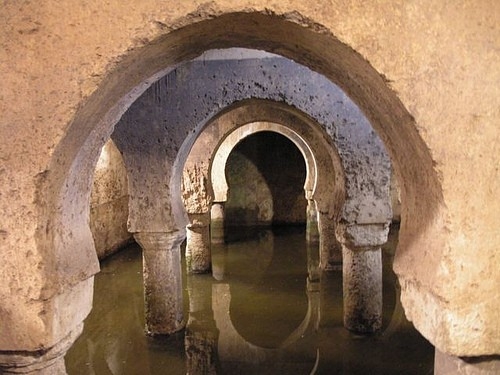
Cáceres is an outstanding city that was ruled from the 14th to 16th centuries by powerful rival factions: fortified houses, palaces and towers dominate the views of the city. This city, in the heart of Extremadura, bears the traces of highly diverse and contradictory influences, such as Islamic arts, Northern Gothic, Italian Renaissance, arts of the New World, etc. The walls of the city bear exceptional testimony to the fortifications built in Spain by the Arab Almohads.
Caceres or Caesarina, its name in the 6th century, played only a minor role in the Visigothic Kingdom. It had lost almost all its prominence when the Arabs seized it and made it a fortified city, called Qasri, which in the 12th century Al-Idrisi saw as the principal bridgehead against the Christians. Moreover, during the 12th-century wars, after the Almohads had lost and then retaken the city several times, they built remarkable fortifications which completely changed the appearance of the Roman walls which had marked the boundaries of Caesarina, although few example of these walls are still visible today. Flanking towers were positioned externally a few metres from the rampart and connected to it by a wall; five of the towers, rectangular in shape, still stand to the west, including the famous Torre del Bujaco; two polygonal towers can be seen to the south (Torre Redonda and Torre Desmochada); to the east, the Torre de los Pozos, rising 30 m above the rampart walk, is partly built into a barbican.

Few monuments have survived from the Muslim period within the walls, however the most significant is the five-nave reservoir with three bays, incorporated into the Casa de las Veletas in the 16th century. Although most of the monuments have been lost (the site of the Alcázar was parcelled out in 1473), the pattern of the streets, with winding backstreets that open on tiny squares or turn into narrow alleys, is a survival from urban planning during the Almohad period. The number of patios and interior gardens also bears testimony to the influence of Qasri on Cáceres.


Alfonso IX, King of León, recaptured the city from the Moors in 1229. The destiny of Cáceres shifted again in the 14th century with the massive influx of noblemen who had initially been excluded from repoblación as a result of measures imposed by Alfonso IX. In the space of a few decades, fortified houses dotting the landscape made the city a perfect example of a feudal city, which since 1312 had been the stage for power struggles between rival clans. Notable among the oldest seigniorial fortresses are the Palacio de la Generala, the house and tower de las Cigüeñas, Casa de Los Ovando-Perero, Torre de Los Espaderos, and Casa Espadero-Pizarro or Casa del Mono.
 In the 15th and 16th centuries, noble pride was demonstrated by richly decorated coats of arms and a surge of towers, battlements and fortified residencies. The Catholic Kings tore down most of these unusual constructions but preserved some in deference to the wishes of a few select noblemen (e.g. Palacio de Los Golfines de Arriba, Palacio de las Cigüeñas). Only their smaller proportions and a more modest system of defence distinguishes the city's exquisite stone houses from the palaces (Casa de Aldana, Casa del Sol, Casa del Aguila, Casa de Ulloa, Casa de Carvajal, etc.). When the 'Americans' returned, new palaces were constructed: Palacio Godoy, built by a newly rich "conquistador" and Palacio de Los Toledo-Moctezuma, built in the second half of the 16th century for the grandson of the Aztec who had greeted Cortes when he reached Mexico.
In the 15th and 16th centuries, noble pride was demonstrated by richly decorated coats of arms and a surge of towers, battlements and fortified residencies. The Catholic Kings tore down most of these unusual constructions but preserved some in deference to the wishes of a few select noblemen (e.g. Palacio de Los Golfines de Arriba, Palacio de las Cigüeñas). Only their smaller proportions and a more modest system of defence distinguishes the city's exquisite stone houses from the palaces (Casa de Aldana, Casa del Sol, Casa del Aguila, Casa de Ulloa, Casa de Carvajal, etc.). When the 'Americans' returned, new palaces were constructed: Palacio Godoy, built by a newly rich "conquistador" and Palacio de Los Toledo-Moctezuma, built in the second half of the 16th century for the grandson of the Aztec who had greeted Cortes when he reached Mexico.

As always it's not all just about history and when visiting a city one must eat, fortunately, Caceres is also a wonderful city in gastronomic terms. The gastronomy of Caceres and the province of Extremadura is flavourful and varied, in which the Ibérico pig plays a major role, thanks to the quality of the processed meat products made in the region. Roast, stewed lamb, a variety of freshwater fish and game dishes are examples of the sobriety of Extremaduran cuisine. The vegetables produced in this region are also of widely recognised quality, particularly the asparagus and thistle greens. Among the fruits, apples, peaches and cherries from the Jerte Valley are worthy of special mention. Extremadura produces a type of cheese that is unique in Spain, the so-called tortas. With two Designations of Origin, PDO Torta del Casar and PDO Queso de la Serena, these are cheeses with a light, creamy texture and powerful flavour, some of Spain's most unusual. Honey, dried fruits and pastries such as 'perrunillas' (sweet biscuits made with anise) or técula-mécula (a rich almond cake) are all magnificent desserts from Extremadura.

Ver mapa más grande